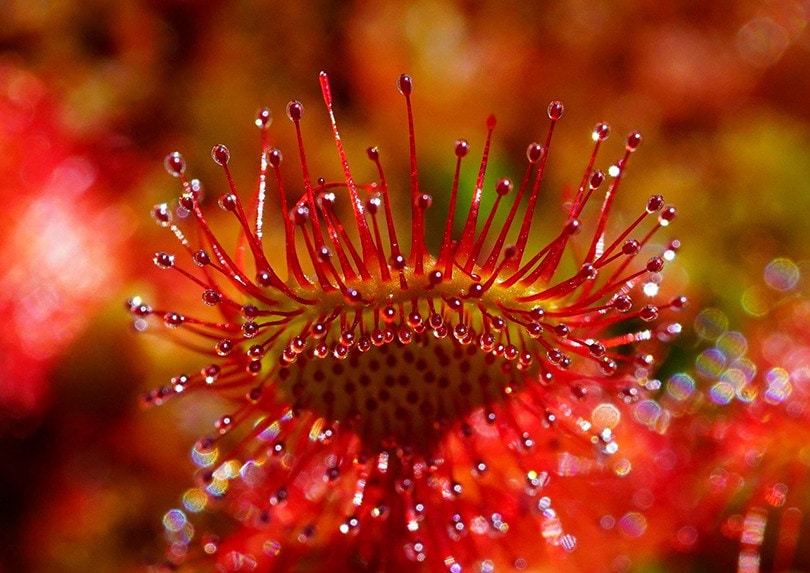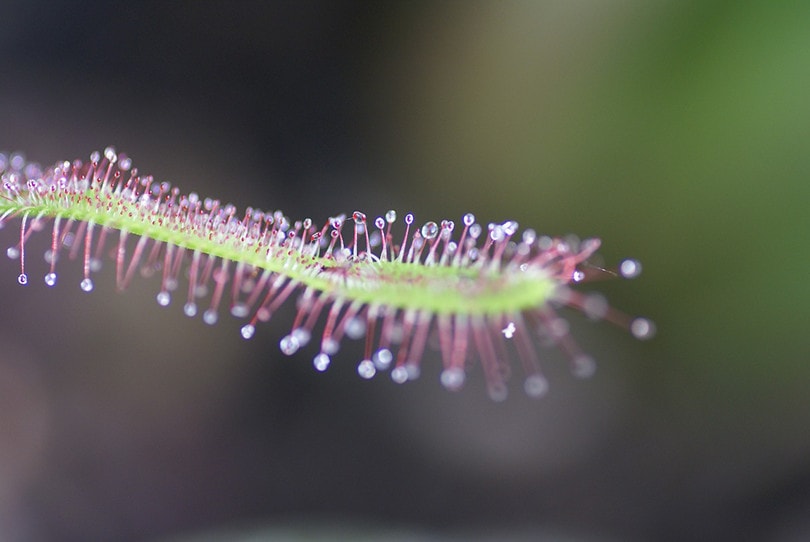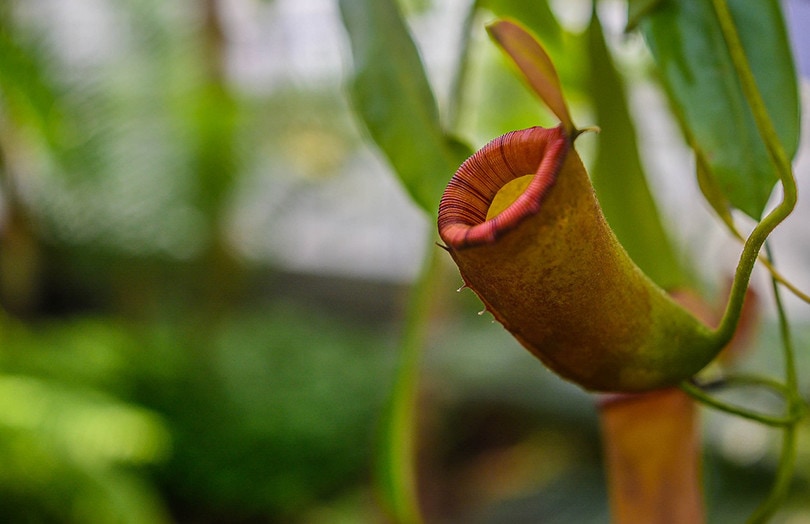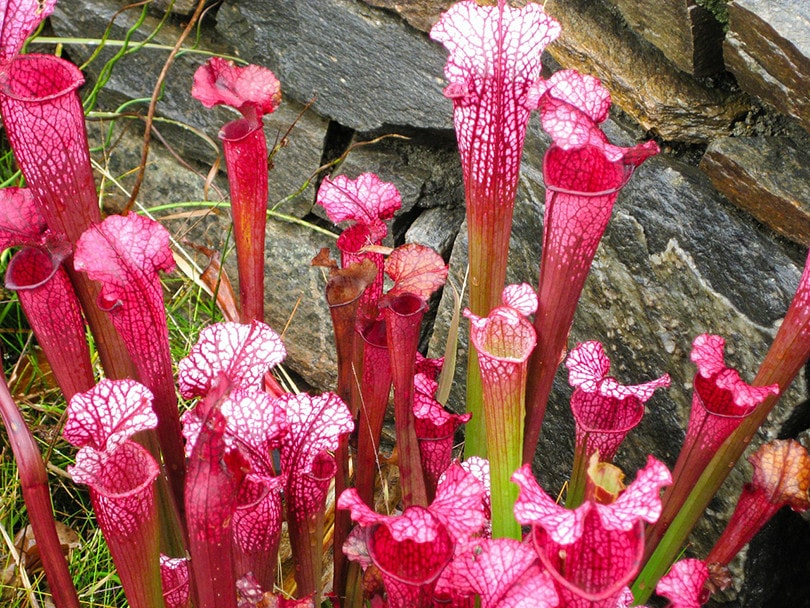5 Easiest Carnivorous Plants to Grow (With Pictures)
-
Shea Cummings
- Last updated:

Some people grow plants to eat them, and some grow them to smell them and enjoy their beauty—but some people grow plants to watch them eat stuff! Carnivorous plants are one of nature’s strange wonders. There are hundreds of different varieties, and many of them require particular growing conditions. However, some are hardy enough for easy indoor growing. Below, we’ve put together a list of five of the easiest carnivorous plants to grow.
The 5 Easiest Carnivorous Plants to Grow
1. Cape Sundew (Drosera capensis)

| Origin: | Subtropical Region of South Africa |
| Height: | 3 inches |
| Light: | Bright, indirect |
| Water: | Rainwater, distilled |
The long, slender leaves of the cape sundew have tentacle-like hairs covered in a sticky juice that draws small insects to their doom. Once the insect lands, they are stuck, the leaf closes, and digestive enzymes begin the process of breaking down the protein to feed the plant.
Because of their subtropical origins, cape sundews prefer high humidity. Unless you live in an extremely humid area—and keep it humid in your home—then a terrarium or Wardian case are good options for giving your little carnivore the moist environment it needs.
2. Butterworts (Pinguicula)
| Origin: | Central America |
| Height: | 1–6 inches |
| Light: | Full sun, partial shade |
| Water: | Rainwater, distilled |
Butterworts are beginner-friendly carnivorous plants. However, due to their preference for being outdoor plants, they are only suitable for warmer zones or potted annuals. If you live in zones 10 or 11, they will usually persist through the winter months and grow new rosettes every year.
This carnivorous plant doesn’t need a lot of extra care. As long as you plant them in the proper soil, they will do what they need to do to survive. One thing to note about butterworts is that they cannot dry out. So, if there hasn’t been much rain, you have to make sure you keep their soil moist. But do so with distilled water as they are sensitive to certain minerals and salt concentrations.
3. Pitcher Plant (Nepenthes ventrata)

| Origin: | Philippines |
| Height: | 8 inches |
| Light: | Bright, indirect |
| Water: | Rainwater, distilled |
This tropical pitcher plant is actually a cross of two carnivorous plants native to the Philippines. It is widely available and a common indoor plant due to being relatively easy to grow. You will usually find this plant in a hanging basket with its “pitchers” dangling below doing their insect-devouring job.
Temperature-wise, this hybrid doesn’t require anything special, but it appreciates higher humidity because of its tropical origins. And, like most other carnivorous plants, it is sensitive to water, so rainwater is preferable, but distilled water will do the trick.
4. South African Sundew (Drocena natalensis)
| Origin: | South Africa |
| Height: | 2 inches (across) |
| Light: | full sun, direct light |
| Water: | distilled, purified |
The South African sundew stands apart from the other plants on this list. It has minimal requirements for temperature, humidity, or light. It also has a very distinct look—like a spiky green starfish with white and pink spikes.
When grown in a tray, it doesn’t require a humid environment; approximately two inches of distilled or purified water in the tray will do the job. As far as temperature is concerned, a spread from 40–90 degrees is acceptable. If you are in a frost-free zone, then it even thrives outdoors.
5. Purple Pitcher Plant (Sarracenia purpurea)

| Origin: | Humid regions of North America |
| Height: | 6–36 inches |
| Light: | Direct light |
| Water: | Rainwater, distilled |
The purple pitcher plant is another pitcher plant variation that is suitable for indoor and beginner growing. It is relatively hardy when it comes to temperature and can withstand winter temperatures as low as 40 degrees Fahrenheit. They require humidity above 50%, which is easily accomplished with a humidity tray.
When it comes to watering your purple pitcher plant, they are best potted in a pot with drainage holes over a tray. Water until the tray fills up but don’t empty it because your plant will absorb that water as it needs it. The plant may go dormant over the winter months, depending on the temperature. If it does, only water it enough to keep the soil moist, and make sure it stays in bright light or direct sun all year round.
No Venus Flytrap?
You may be wondering why the iconic Venus flytrap is not on this list. While it’s definitely the most common plant one thinks about in regards to carnivorous plants, it’s not the easiest to care for. There are a couple of varieties that are easier than others. But as a general rule, the Venus flytrap is better left to the experienced carnivorous plant grower.
High Humidity Needed
Even the least demanding of these carnivorous plants will typically need higher humidity than the average household will have. Here are a few ways that you can increase humidity for the plants without necessarily increasing it for the entire house.
- Mist plants with a spray bottle
- Put the plants in your bathroom for a humidity boost
- Put plants on a humidity tray
- Open terrarium or Wardian case
 Conclusion
Conclusion
Sometimes, the idea of growing a tropical or subtropical plant can be overwhelming. It doesn’t have to be. Hopefully, this list has demonstrated that growing a tropical carnivorous plant can be a unique and rewarding experience with the right tools and knowledge.
Featured Image Credit: Hans, Pixabay
Contents

